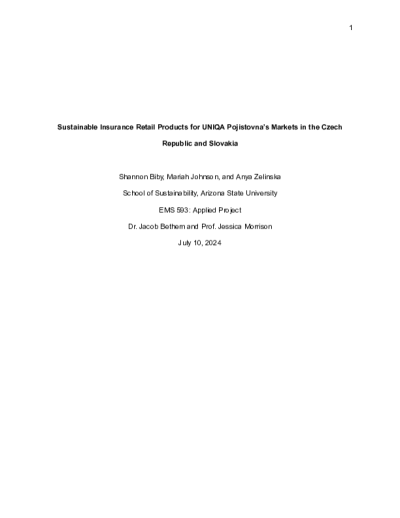Matching Items (45,029)

Description
The City of Phoenix has faced challenges in tracking its energy usage and intensity. With 2030 climate goals soon approaching, the city needs accurate data collection and ways to properly reduce the energy usage of the city's operations. City and operational aspects were assessed focusing on metrics of per capita, costs, productions, and per passenger. Additional opportunities included community engagement and other available data management systems to consider. The next steps include removing interdepartmental silos and implementing the listed metrics in the short and in the long term following in the footsteps of cities like Mesa.
ContributorsFrost, Veronica (Author) / Goodlin, Seth (Author) / Richardson, Renee (Author) / Speer, Andrew (Author)
Created2024-07-10

Description
"Decarbonizing the building and construction industry, ""the built environment,"" is critical to aligning with the United Nations (U.N.) Sustainable Development Goals (SDGs) and achieving the goals outlined in the Paris Agreement. Due to numerous factors, including global population increases, the industry's growth and resulting impacts on emissions and resource depletion are increasing every year.
The global construction materials industry's financial value was $1,320.01 billion in 2023 and is projected to grow to $1,867.16 billion by 2032. Significant environmental challenges accompany this growth. The building and construction sector contributes 37% of global emissions through the embodied carbon of materials extraction, manufacturing, on-site construction, and operational emissions from heating, cooling, and lighting (Abergel et al., 2019).
Our research highlights critical materials, outlines seven stages of the material life cycle, identifies potential risks and impacts, and offers recommendations for a more just and sustainable future in the construction materials industry (Dsilva, 2023). This comprehensive approach aims to understand better the industry's current landscape and actionable insights for driving sustainable practices."
ContributorsChristiaanse, Madelon (Author) / Grimm, Nick (Author) / Haj, Christelle (Author) / Bethem, Jacob (Contributor) / Morrison, Jessica (Contributor) / BWD Strategic (Contributor)
Created2024-07-03
Description
"Colgate-Palmolive is a sustainability-conscious organization that has established its Net Zero strategy. It has been considering utilizing an internal carbon pricing (ICP) scheme as the next step in its decarbonization journey, but the starting point for its implementation is still uncertain. Our group has been tasked with researching and benchmarking the current internal prices other organizations are using and the best practices they are utilizing to drive changes with the final goal of recommending a strategy that would best fit Colgate-Palmolive's needs. We began our research with a baseline finding of where Colgate was in its sustainability journey and understanding how ICP schemes were used in the market. After conducting a PESTEL analysis to understand the trends in the greater consumer industry, our group began the peer research on the following organizations: Microsoft, Reckitt, Unilever, Mars, PepsiCo, and P&G. Our group presented the findings of our research in three deliverables: A benchmark table, a decision tree map, and a data requirements graphic. With our research conducted and taking into account Colgate's existing Net Zero strategy, we recommended that the most compatible ICP schemes for Colgate would be a shadow price on CAPEX decisions and a shadow price on the OPEX decisions of Colgate's procurement department. To conclude our report, we laid out four next steps Colgate should take to implement the ICP schemes we have recommended."
ContributorsYakhnitskiy, Mikhail (Author) / Davis, Ryan (Author) / Aguilar, Martin (Author) / Colgate-Palmolive Company (Contributor)
Created2024-07-03

Description
UNIQA Pojistovna is an insurance provider in the Czech Republic and Slovakia with a goal to implement sustainability features into their retail product offerings. Without a consumer-facing strategy that meets internal goals for sustainability, there is a risk of decreased competitiveness and brand value as the European Union focuses on adopting mandatory ESG measures. This report covers background research on the insurance industry and best practices implemented by peers and competitors throughout the U.S., E.U., and U.K. markets. With an understanding of the market landscape, our group explores options for UNIQA to embed sustainability features into their home, car, life, and travel insurance products. Our recommendations include original ideas to create partnerships with various entities, including home improvement stores and car manufacturers, creating interactive educational tools for customers, enhancing internal education among brokers and corporate employees, and exploring green life insurance and end-of-life offerings. Finally, this report provides a recommended timeline for implementation and next-step actions.
ContributorsBiby, Shannon (Author) / Johnson, Mariah (Author) / Zelinska, Anya (Author) / Bethem, Dr. Jacob (Contributor) / Reeves, Charles (Contributor) / Morrison, Jessica (Contributor) / UNIQA Pojistovna (Contributor)
Created2024-07-10

Description
This project will attempt to supplement the current registry of lesbian inquiry in literature by exploring a very specific topos important to the Modern era: woman and her intellect. Under this umbrella, the project will perform two tasks: First, it will argue that the Modern turn that accentuates what I call negative valence mimesis is a moment of change that enables the general public to perceive lesbianism in representations of women that before, perhaps, remained unacknowledged. And, second, that the intersection of thought and resistance to heteronormative structures, such as heterosexual desire/sex, childbirth, marriage, religion, feminine performance, generate topoi of lesbianism that lesbian studies should continuously critique in order to index the myriad and creative ways through which fictional representations of women have evaded their proper roles in society. The two tasks above will be performed amidst the backdrop of a crucial moment in history in which lesbianism jumped from fiction to fact through the publication and obscenity trial of Radclyffe Hall's novel, The Well of Loneliness. Deconstructive feminist and queer inquiry of under-researched novels by women from the UK and the US written within the decade surrounding the trial reveals the possibilities of lesbianism in novels where the protagonists' investment in heteronormativity has remained unquestioned. In those texts where the protagonists have been questioned, the analysis of lesbianism will be delved into more deeply in order to illustrate new ways of reading these texts. I will focus on women writers who, as Terry Castle suggests, "both usurped and deepened the [lesbian] genre" with the arrival of the new century (Literature 29). It is my attempt to combat heteronormativity through a more positive approach. As Michael Warner asserts, "heteronormativity can be overcome only by actively imagining a necessarily and desirably queer world" (xvi). This is not to say this study will be all roses and no thorns; a desirably queer world is not about a wish for an utopia. For this project, it is about rigorously engaging in the lesbianism of literature while acknowledging how a lesbian reading, a reading for lesbianism, can continue to both expand and enrich the critical tradition of a text and the customary interpretation of various characters.
ContributorsWagner, Johanna M. (Author) / Clarke, Deborah (Thesis advisor) / Lussier, Mark (Thesis advisor) / Mallot, Edward (Committee member) / Arizona State University (Publisher)
Created2012

Description
Real-time monitoring of active distribution systems can be done by using micro-phasor measurement units (µPMUs). In the first part of this report, an innovative μPMU placement algorithm is presented to completely observe the system and facilitate state estimation for unbalanced distribution systems. The proposed algorithm considers practical constraints such as single-phase laterals, distributed loads and variable tap-ratios and ensures complete phase observability while minimizing the number of μPMUs needed. However, complete observability of distribution systems may not be economically and practically viable. Hence, in the second part of this report the challenge of limited availability of μPMUs in distribution systems is addressed using deep learning (DL). The proposed DL-based method offers superior accuracy with fewer μPMUs compared to conventional least squares method, even during topology changes. The robustness of the deep neural network (DNN) used in DL is further evaluated by considering realistic measurement errors in the μPMUs, ensuring the practicality of the approach.In the third part of this report, the research delves into the verification of the DNN for distribution system state estimation (DSSE) by analyzing its performance under input perturbations. A mixed-integer linear programming (MILP) approach is proposed to analytically verify the DNN's robustness. This ensures that the DNN output remains bounded given a bounded perturbation in the input. This essentially builds trust in using DNN-based solutions for critical tasks such as power grid monitoring. Finally, due to the scalability challenges of MILP problems, a linear bound propagation method is proposed for DNN verification. The proposed method significantly increases the speed (of verification) and makes the verification problem scalable for wider and deeper DNNs.
In conclusion, this research provides a comprehensive monitoring framework for distribution system operators, empowering them to effectively manage the addition of distributed energy resources. It combines optimal μPMU placement, a robust DNN-based DSSE, and a rigorous DNN verification analyses. By ensuring reliable and trustworthy system monitoring, the approaches developed in this report can contribute to a more stable, resilient, and renewable-rich power distribution grid.
ContributorsAzimian, Behrouz (Author) / Pal, Anamitra (Thesis advisor) / Vittal, Vijay (Committee member) / Ayyanar, Raja (Committee member) / Dasarathy, Gautam (Committee member) / Arizona State University (Publisher)
Created2024

Description
Celiac Disease (CD) is now widespread as one in 133 people are currently diagnosed, while there were only one in 150 in 2006. Much of the research concerning CD is still in the early stages, as formal epidemiological studies are relatively recent. CD is aggravated by the consumption of gluten, which is found mainly in wheat, rye, oats, and barley. Not surprisingly, the rising prevalence of CD has created a significant business opportunity for food manufacturers in developing products that are tailored to CD sufferers. While the entire Gluten-Free (GF) industry has been experiencing double digit growth rates, the expansion in available snack foods has outstripped all others. Observation of GF snack food prices suggests that food manufacturers are responding to high retail prices associated with GF foods. However, GF foods are often also advertised with other attributes that generally sell for a premium over conventional foods. Therefore, whether the high retail price for GF snack foods can be attributed specifically to the GF attribute is an empirical question. The objective of this research is to determine whether there is a retail-price premium for GF snack foods and, if there is, to estimate its magnitude. A hedonic pricing model is used to answer this question. Specifically, a hedonic pricing model was applied to a unique dataset of snack food products in order to estimate the marginal value for the GF attribute, while controlling for a number of other important attributes. Results show that the GF attribute is both economically and statistically significant, implying a premium of nearly $1.86 above gluten-containing products. Production costs for smaller manufacturers can be two to three times higher for GF foods relative to non-GF foods, but this still implies an excess premium of over $0.50 (assuming 40% margins). However, high premiums may not last as large retailers are utilizing their influence over suppliers to keep retail margins low. Therefore, the primary implication of the research is that the rapid growth in recent years can easily be explained on economic grounds for large agribusinesses, as this implies a major profit opportunity.
ContributorsSampson, Jed Philip (Author) / Richards, Timothy (Thesis advisor) / Manfredo, Mark (Committee member) / Pofahl, Geoffrey (Committee member) / Arizona State University (Publisher)
Created2010
ContributorsFarmer, Madeline (Performer) / Novak, Gail (Pianist) (Performer) / Jeong, Jieun (Performer) / ASU Library. Music Library (Publisher)
Created2024-04-06
ContributorsCamras, Ilana (Performer) / Morgan, Wade (Performer) / ASU Library. Music Library (Publisher)
Created2024-03-28
ContributorsChung, Kylie (Performer) / Glomb, Lauren (Performer) / Davis, Austin (Performer) / Nguyen, Sarahkim (Performer) / ASU Library. Music Library (Publisher)
Created2024-04-06